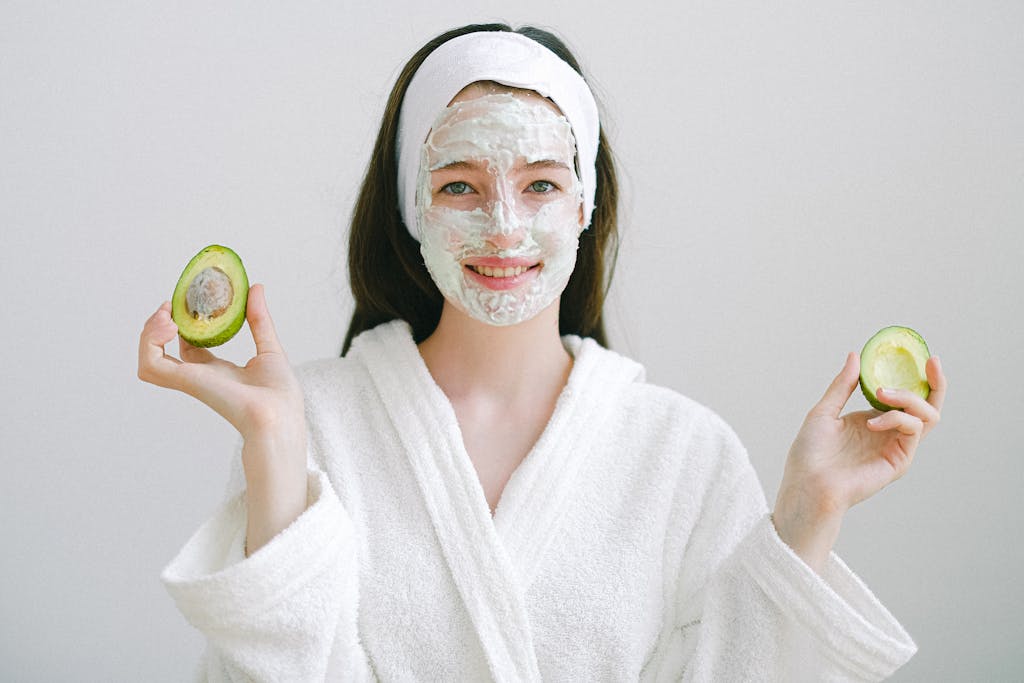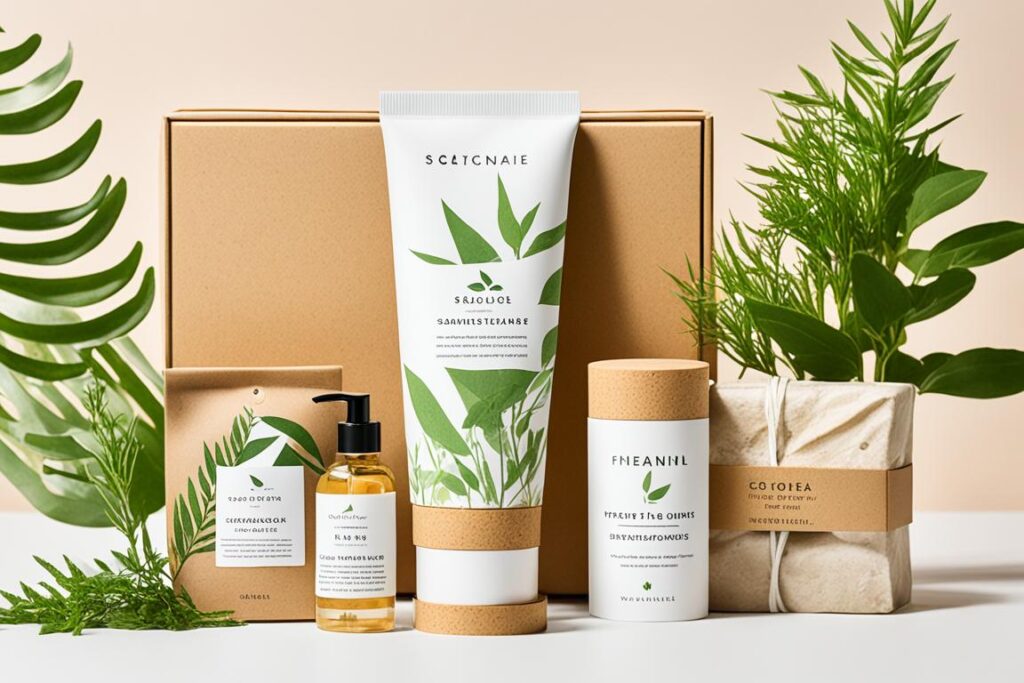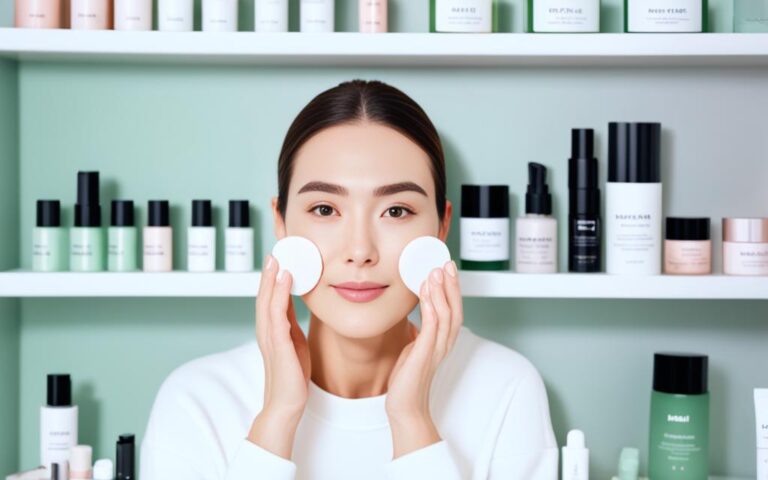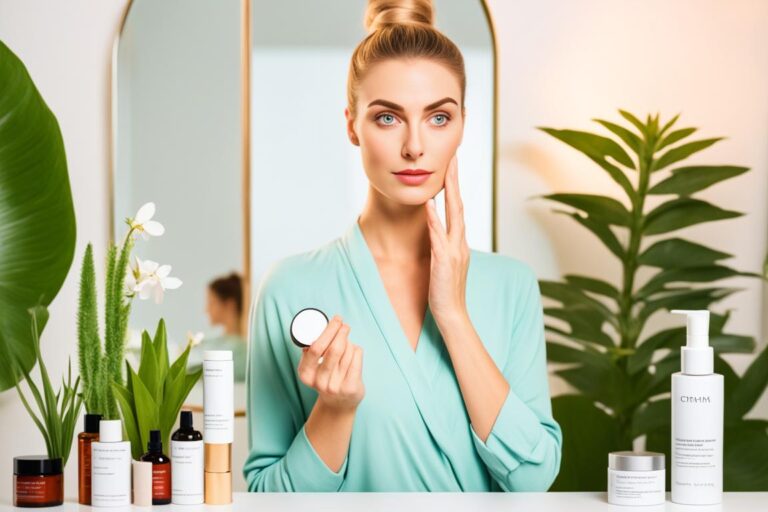Unlock the Eco-Power: A Holistic and Eco-Friendly Approach to Skincare
Skincare, often seen as a cosmetic pursuit, offers a deeper connection to our overall health. As the body’s largest organ, our skin serves as a protective barrier against the outside world, reflecting our well-being in more ways than one.
But nourishing this vital organ goes beyond just achieving a radiant complexion. In this post, we’ll explore the transformative power of a holistic and eco-friendly approach to skincare. This philosophy extends far beyond surface-level beauty, nurturing your skin while minimizing environmental impact. We’ll delve into the importance of skincare and unveil practices that benefit both your skin and the planet.

The Significance of Skincare
A radiant, healthy complexion is not just a matter of aesthetics; it is an indicator of our internal health. Our skin serves as a mirror, reflecting the state of our overall well-being. From protecting us against harmful UV rays to defending against pollutants and microbes, our skin tirelessly fulfills its duty. Neglecting its care can lead to a myriad of issues, ranging from premature aging to more serious dermatological conditions.
The Holistic and Eco-Friendly Approach to Skincare
Amidst the plethora of skincare options available, a holistic and eco-friendly approach emerges as a beacon of health and sustainability. This approach recognizes that healthy skin isn’t achieved through topical treatments alone. Instead, it emphasizes a comprehensive lifestyle that encompasses factors beyond skincare products. Additionally, the eco-friendly aspect underscores the importance of choosing
products that not only benefit our skin but also contribute positively to the environment. By adopting this approach, you not only nourish your skin but also play a role in fostering a healthier planet.
As we embark on this journey of exploring the synergy between holistic skincare and eco-friendliness, let’s unravel the secrets to achieving not just a beautiful complexion but a balanced and sustainable lifestyle. Join us in discovering the transformative power of conscientious skincare practices.
Understanding Holistic Skincare
In our quest for healthier, more vibrant skin, the holistic approach beckons us to broaden our perspective beyond conventional skincare practices. Holistic skincare is not merely a set of routines; it’s a philosophy that considers the interconnectedness of our body, mind, and environment.
Definition and Principles of Holistic Skincare
At its core, holistic skincare acknowledges that our skin is a reflection of our internal health. It advocates for a well-rounded approach that addresses not only external factors but also internal imbalances. From nutritional choices to stress management, holistic skincare encourages a lifestyle that nurtures overall well-being. This chapter will delve into the principles guiding holistic skincare, providing a foundation for a more comprehensive and sustainable beauty regimen.

Connection Between Inner Health and Outer Beauty
The intimate link between what we put inside our bodies and the appearance of our skin is undeniable. The foods we consume, our hydration levels, and even our mental state can significantly impact the health of our skin. We’ll explore how adopting a holistic mindset can lead to not just a cosmetic transformation but a profound improvement in your overall health.
Importance of a Well-Rounded Routine
Holistic skincare is not about quick fixes; it’s about cultivating habits that endure. We’ll discuss the significance of a well-rounded skincare routine that goes beyond cleansing and moisturizing. Incorporating practices such as mindfulness, adequate sleep, and regular exercise becomes integral in nurturing your skin from the inside out.
As we venture into the realm of holistic skincare, prepare to embrace a broader, more interconnected approach to beauty—one that recognizes the harmony between our internal well-being and the radiance we seek on the outside. Join us on this journey of self-discovery and transformative skincare practices.
Benefits of Natural Ingredients
Having established the groundwork for holistic skincare, let’s shift our focus to the ingredients that can truly revolutionize your beauty routine. Natural ingredients, gifted to us by Mother Nature, offer a multitude of benefits for the skin without the drawbacks of harsh chemicals. In this chapter, we’ll explore the captivating world of natural elements that cater to diverse skin types and concerns.
Natural ingredients are often praised for their beneficial properties when it comes to skincare. Here’s a list of various natural ingredients known for promoting skin health:
1. Aloe Vera:
-Benefits: Soothing, hydrating, and anti-inflammatory. Ideal for sunburns and irritated skin.
2. Honey:
-Benefits: Antibacterial, moisturizing, and antioxidant-rich. Suitable for acne-prone and dry skin.
3. Coconut Oil:
– Benefits: Moisturizing, antimicrobial, and rich in fatty acids. Nourishes and hydrates the skin.
4. Tea Tree Oil:
– Benefits: Antimicrobial and anti-inflammatory. Effective for treating acne and skin infections.
5. Olive Oil:
– Benefits: Rich in antioxidants and fatty acids. Nourishes and moisturizes the skin.
6. Green Tea:
– Benefits: Antioxidant-rich, anti-inflammatory, and may help with sun damage. Suitable for various skin types.
7. Chamomile:
– Benefits: Soothing and anti-inflammatory. Calms sensitive skin and reduces redness.
8. Jojoba Oil:
– Benefits: Moisturizing and closely resembles the skin’s natural oils. Suitable for all skin types.
9. Shea Butter:
– Benefits: Deeply moisturizing and rich in vitamins. Helps with dry and flaky skin.
10. Cucumber:
– Benefits: Hydrating and soothing. Contains antioxidants that refresh and revitalize the skin.
11. Avocado:
– Benefits: Rich in fatty acids and vitamins. Nourishes and moisturizes the skin.
12. Rosehip Oil:
– Benefits: High in antioxidants and essential fatty acids. Known for promoting skin regeneration and reducing scars.
13. Turmeric:
– Benefits: Anti-inflammatory and antioxidant. Helps with acne, eczema, and other skin conditions.
14. Oatmeal:
– Benefits: Soothing and anti-inflammatory. Great for relieving irritated and itchy skin.
15. Witch Hazel:
– Benefits: Astringent and anti-inflammatory. Tones the skin and helps with acne.
16. Calendula:
– Benefits: Anti-inflammatory and promotes wound healing. Suitable for sensitive skin.
17. Grapeseed Oil:
– Benefits: Lightweight and rich in antioxidants. Moisturizes without clogging pores.
18. Pomegranate Extract:
– Benefits: Antioxidant-rich and promotes collagen production. Anti-aging benefits.
19. Argan Oil:
– Benefits: Moisturizing and rich in vitamin E. Nourishes and revitalizes the skin.
20. Lavender Oil:
– Benefits: Calming and antimicrobial. Suitable for sensitive and acne-prone skin.
It’s important to note that while these natural ingredients offer various benefits, individual skin types may react differently. Always perform a patch test when trying new ingredients, and consider consulting with a dermatologist, especially if you have specific skin concerns or conditions. Additionally, the quality and source of these natural ingredients can impact their effectiveness, so choosing reputable products is key.
Introduction to the Harmful Effects of Synthetic Chemicals
Before we delve into the beauty of natural ingredients, it’s crucial to understand the potential harm lurking in synthetic chemicals. Many conventional skincare products contain harsh additives that can strip the skin of its natural oils, leading to irritation and long-term damage. We’ll explore the adverse effects of these synthetic compounds, shedding light on why a shift towards natural alternatives is not just a trend but a necessity.
The skincare and beauty industry has long utilized synthetic compounds in their formulations for various reasons, including cost-effectiveness, stability, and prolonged shelf life. However, a growing body of evidence suggests that some synthetic compounds may have adverse effects on both skin health and the environment. Here, we’ll explore the potential drawbacks of synthetic compounds, emphasizing why a shift towards natural alternatives is not just a trend but a necessity.
1. Skin Sensitivity and Irritation:
– Synthetic Fragrances: Many skincare products contain synthetic fragrances, which can cause skin sensitivity and irritation, especially for individuals with sensitive skin. Natural alternatives like essential oils can provide fragrance without the potential side effects.
2. Allergic Reactions:
– Artificial Colorants: Synthetic dyes and colorants are known to cause allergic reactions and skin irritation. Natural colorants, such as those derived from plants, pose a lower risk of adverse reactions.
3. Hormone Disruption:
– Parabens: Synthetic preservatives like parabens are known for their antimicrobial properties, but they have been linked to hormone disruption. Some studies suggest that parabens may mimic estrogen and potentially contribute to hormone-related issues.
4. Environmental Impact:
– Microplastics: Synthetic microplastics, often found in exfoliating beads and some cleansers, contribute to environmental pollution. These microplastics do not break down easily and can harm marine life. Natural exfoliants, such as sugar or bamboo particles, are biodegradable alternatives.
5. Carcinogenic Concerns:
– Phthalates: Found in some synthetic fragrances, phthalates have been associated with potential carcinogenic effects. Natural fragrances, derived from plant extracts, offer a safer alternative without the associated health concerns.
6. Residue Buildup:
– Silicones: While silicones provide a smooth texture, they can create a film on the skin, potentially leading to residue buildup. Natural alternatives like plant oils provide similar benefits without the risk of buildup.
7. Overuse of Antibiotics:
– Triclosan: Used in some antibacterial skincare products, triclosan has been linked to antibiotic resistance. Natural antibacterial agents, such as tea tree oil or honey, offer alternatives without contributing to antibiotic resistance.
8. Environmental Hormone Mimics:
– Phenols and Phthalates: Certain synthetic compounds, including phenols and phthalates, can act as endocrine disruptors in the environment, affecting aquatic life and ecosystems. Natural ingredients pose fewer risks to environmental health.
9. Skin Dehydration:
– Sulfates: Commonly found in cleansers, sulfates can strip the skin of its natural oils, leading to dehydration and irritation. Natural alternatives, like coconut-derived cleansers, provide effective cleansing without the harsh effects.
10. Ethical and Sustainability Concerns:
– Palm Oil: Some synthetic compounds, such as certain emollients and surfactants, may contain palm oil derivatives, contributing to deforestation and environmental degradation. Sustainable and ethically sourced natural ingredients offer eco-friendly alternatives.
The shift towards natural alternatives is driven by a growing awareness of the potential adverse effects of synthetic compounds on both individual health and the environment. Choosing products with natural, plant-based ingredients not only minimizes the risk of adverse reactions but also supports sustainability and ethical practices in the skincare industry.
As consumers become more informed, the demand for transparent, eco-conscious, and naturally derived skincare options continues to rise, making this shift not just a trend but a necessary evolution in the beauty landscape.
Spotlight on Key Natural Ingredients
From the soothing properties of Aloe-Vera to the nourishing effects of coconut oil, we’ll shine a spotlight on a range of natural ingredients that have proven their efficacy in skincare. Each ingredient brings a unique set of benefits, catering to specific skin types and concerns. Whether you’re combating dryness, acne, or signs of aging, nature provides a remedy for every skin woe.
Skin-Specific Benefits for Various Skin Types
Understanding your skin type is the first step towards a personalized skincare routine. This chapter will guide you through the benefits of natural ingredients tailored to different skin types – oily, dry, sensitive, or combination. Discover how these gifts from nature can restore balance, enhance your skin’s natural radiance, and address specific issues you may be facing.
Prepare to embark on a journey through the lush landscapes of natural skincare. By incorporating these bountiful gifts into your routine, you’re not only choosing what’s best for your skin but also embracing a cleaner, greener approach to beauty. Stay with us as we unveil the secrets to unlocking your skin’s full potential, naturally.
DIY Skincare Recipes
Now that we’ve explored the benefits of natural ingredients, it’s time to roll up our sleeves and dive into the world of do-it-yourself skincare. Creating your own skincare products not only allows you to tailor formulations to your specific needs but also reduces your reliance on commercial products with potentially harmful ingredients. Let’s embark on a journey of crafting homemade face masks, gentle exfoliating scrubs, and nourishing toners and moisturizers using readily available natural ingredients.

Homemade Face Masks Using Natural Ingredients
A1. Soothing Aloe Vera Mask:
– Ingredients: Fresh aloe vera gel, honey, and a splash of cucumber juice.
– Benefits: Calms irritated skin, reduces redness, and provides hydration.
2. Revitalizing Avocado Mask:
– Ingredients: Mashed ripe avocado, plain yogurt, and a teaspoon of honey.
– Benefits: Nourishes and moisturizes, leaving your skin feeling supple and rejuvenated.
3. Detoxifying Clay Mask:
– Ingredients: Bentonite clay, apple cider vinegar, and a drop of tea tree oil.
– Benefits: Draws out impurities, controls excess oil, and promotes a clearer complexion.
B. DIY Scrubs and Cleansers for Gentle Exfoliation
1. Honey and Brown Sugar Scrub:
– Ingredients: Brown sugar, honey, and a dash of coconut oil.
– Benefits: Gently exfoliates, leaving your skin smooth and radiant, while honey provides antibacterial properties.
2. Oatmeal and Yogurt Cleanser:
– Ingredients: Ground oatmeal, plain yogurt, and a touch of chamomile oil.
– Benefits: Cleanses and exfoliates without stripping natural oils, ideal for sensitive skin.
3. Coffee Grounds Exfoliating Scrub:
– Ingredients: Used coffee grounds, coconut oil, and a hint of vanilla extract.
– Benefits: Invigorates and exfoliates, leaving your skin feeling refreshed and promoting blood circulation.
C. Easy-to-Make Toners and Moisturizers
1. Rosewater and Green Tea Toner:
– Ingredients: Rosewater, brewed green tea, and a splash of witch hazel.
– Benefits: Tones and balances the skin, reducing inflammation and providing antioxidant protection.
2. DIY Hydrating Cucumber Toner:
– Ingredients: Fresh cucumber juice, aloe vera gel, and a drop of lavender essential oil.
– Benefits: Hydrates and soothes the skin, leaving it feeling cool and refreshed.
3. Simple Jojoba Oil Moisturizer:
– Ingredients: Jojoba oil, Aloe Vera gel, and a few drops of your favorite essential oil.
– Benefits: Nourishes and moisturizes without clogging pores, suitable for various skin types.
Get ready to pamper your skin with these easy-to-create, natural formulations. Experiment with different recipes to find the perfect match for your skin’s unique needs, and revel in the joy of crafting your own personalized skincare regimen.
Sustainable and Eco-Friendly Options
As we immerse ourselves in the world of natural DIY skincare, it’s equally important to extend our commitment to sustainability. Conventional skincare often comes at a cost to the environment, with excessive packaging and the use of harmful chemicals. In this chapter, we’ll explore the environmental impact of traditional products and introduce sustainable, eco-friendly options that align with our holistic skincare journey.
The Environmental Impact of Traditional Skincare Products
Many skincare products contribute to environmental degradation through excessive packaging, harmful manufacturing processes, and the use of non-biodegradable ingredients. Plastic waste, in particular, poses a significant threat to our oceans and ecosystems. Understanding the environmental toll of our beauty choices is the first step toward making more conscious decisions.
Introduction to Sustainable Skincare Brands
Fortunately, a wave of change is sweeping through the beauty industry, with an increasing number of brands committing to sustainable practices. From recyclable packaging to cruelty-free testing, these brands prioritize both the health of your skin and the well-being of the planet. We’ll spotlight some noteworthy sustainable skincare brands that have embraced eco-friendly initiatives without compromising on product quality.
In the recap section of this post you will find a list of Sustainable Skincare Brands and where to find them.
13 Tips for Reducing Waste in Your Skincare Routine
Reducing our ecological footprint involves not only choosing the right products but also adopting mindful habits. This chapter will offer practical tips for minimizing waste in your skincare routine. From opting for products with minimal packaging to repurposing containers for DIY creations, small changes can collectively make a substantial positive impact on the environment.
Embark on this segment of our holistic skincare journey as we explore sustainable alternatives that not only prioritize the health of your skin but also contribute to a more sustainable and eco-conscious future. By making informed choices, you become an active participant in preserving the beauty of both your skin and the planet.
Minimizing waste in your skincare routine is a commendable step towards a more sustainable lifestyle. Here are practical tips to help you reduce waste and make eco-friendly choices in your skincare routine:

1. Choose Products with Minimal Packaging:
– Purchase brands that use minimal and eco-friendly packaging. Look for products with refill options or those that use recycled and recyclable materials.
2. Buy in Bulk:
– Purchase skincare products in larger sizes or bulk when possible. This reduces the need for multiple smaller containers and minimizes packaging waste.
3. Refillable Containers:
– Some brands offer refillable options for their skincare products. Invest in these refill systems to reduce the amount of packaging that ends up in landfills.
4. DIY Skincare:
– Create your skincare products using simple, natural ingredients. This not only reduces packaging waste but also allows you to customize formulations based on your skin’s unique needs.
5. Reuse and Repurpose Containers:
– Instead of discarding empty skincare containers, clean and repurpose them for other uses. They can be used for storing DIY beauty products, organizing small items, or even as travel-sized containers.
6. Explore Package-Free Options:
– Some brands offer package-free or zero-waste skincare products. These may come in the form of solid bars, concentrates, or reusable containers. Explore these options to minimize waste.
7. Support Refill Stations:
– Look for local stores or brands that offer refill stations for skincare products. Bring your empty containers to refill rather than purchasing new ones each time.
8. Use Reusable Makeup Remover Pads:
– Instead of disposable cotton pads, switch to reusable cloth pads for removing makeup and applying toner. Wash and reuse them to cut down on single-use waste.
9. Mindful Application:
– Practice mindful application to avoid overusing products. Applying the right amount ensures that you won’t run out quickly, reducing the frequency of product replacements.
10. Recycle Properly:
– When you can’t avoid packaging waste, make sure to recycle it properly. Check your local recycling guidelines to ensure that the materials are disposed of in an environmentally friendly way.
11. Choose Multi-Functional Products:
– Use skincare products that serve multiple purposes. For example, a moisturizer with sunscreen can eliminate the need for separate products, reducing overall packaging.
12. Eco-Friendly Disposal:
– If a product is not refillable or recyclable, explore eco-friendly disposal options. Some brands have programs that allow you to send back empty containers for responsible recycling.
13. Share and Swap:
– If you have skincare products that didn’t work for you, consider sharing or swapping them with friends or family. This minimizes waste and allows products to be used to their full potential.
By adopting these tips, you can contribute to a more sustainable and eco-friendly skincare routine while still prioritizing your skin’s health and well-being.
Mindful Consumption
Our exploration of holistic skincare and eco-friendliness wouldn’t be complete without addressing the importance of mindful consumption. In this chapter, we’ll delve into the significance of making informed choices when it comes to skincare products. By reading labels, understanding ingredients, and supporting ethical, cruelty-free brands, you empower yourself to contribute positively to your skin’s well-being and the environment.
Encouraging Readers to Make Informed Choices
The beauty industry often bombards us with an overwhelming array of products, each promising miraculous results. However, not all formulations are created equal, and some may contain ingredients that are harmful to both your skin and the planet. We’ll guide you through the process of deciphering product labels, helping you make choices aligned with your values and well-being.
Reading Labels and Understanding Product Ingredients
Decoding skincare labels can be a daunting task, but it’s a crucial skill for making informed decisions. We’ll break down common ingredients to watch out for, helping you navigate through the jargon and choose products that align with your holistic and eco-friendly skincare goals. From identifying potential allergens to recognizing environmentally harmful additives, you’ll gain the knowledge needed to curate a skincare routine that’s both effective and conscientious.
Supporting Ethical and Cruelty-Free Brands
Ethical consumerism extends beyond personal health to the well-being of animals and workers involved in the production of skincare products. This chapter will spotlight the significance of choosing cruelty-free brands committed to ethical practices. By supporting companies that prioritize animal welfare and fair labor, you contribute to a more compassionate and sustainable industry.
As we delve into the nuances of mindful consumption, let’s empower ourselves to make choices that resonate with our values. By being discerning consumers, we not only nurture our skin but also foster positive change within the beauty industry and beyond.
Supporting ethical and cruelty-free brands is a meaningful step towards promoting responsible consumerism and contributing to a more compassionate industry.
What individuals can do in their everyday lives to support Cruelty-Free brands:
1. Educate Yourself:
– Read Labels: Take the time to read product labels and familiarize yourself with common ingredients. Look for certifications like “Cruelty-Free” or “Leaping Bunny,” which indicate that a product hasn’t been tested on animals.
– Research Brands: Explore brands that prioritize ethical practices. Many cruelty-free brands are transparent about their commitment to animal welfare, sustainability, and fair labor practices.
2. Choose Cruelty-Free Brands:
– Check Certifications: Look for cruelty-free certifications on products. These certifications ensure that neither the product nor its ingredients have been tested on animals.
– Explore Online Resources: Utilize online databases and resources that list cruelty-free brands. Websites like Leaping Bunny, Cruelty-Free Kitty, and PETA’s Beauty Without Bunnies are excellent references.
3. Support Local and Sustainable Brands:
– Explore Local Options: Local and small businesses often prioritize ethical practices. Explore local markets and artisans who may offer cruelty-free and sustainable alternatives.
– Sustainable Packaging: Consider brands that not only refrain from animal testing but also use eco-friendly packaging. Choose products with minimal packaging or packaging made from recycled materials.
4. Be Mindful of Ingredients:
– Avoid Animal-Derived Ingredients: In addition to avoiding products tested on animals, consider products that don’t contain animal-derived ingredients. Many cruelty-free brands also offer vegan options.
– Look for Alternatives: Ethical brands often use plant-based or synthetic alternatives to animal-derived ingredients. Educate yourself on these alternatives to make informed choices.
5. Support Brands with Ethical Values:
– Corporate Social Responsibility: Choose brands that practice corporate social responsibility. These companies often engage in fair labor practices, community engagement, and environmental stewardship.
– Transparency: Support brands that are transparent about their sourcing, manufacturing, and labor practices. Brands that disclose this information are more likely to align with ethical values.
6. Share Information:
– Social Media Advocacy: Share your discoveries on social media. Use platforms to raise awareness about cruelty-free brands, ethical practices, and the importance of making conscious choices.
– Engage with Brands: Engage with brands on social media to express your support for their ethical practices. Positive feedback encourages companies to maintain and expand their commitment to cruelty-free and ethical initiatives.
7. Encourage Others:
– Educate Friends and Family: Share your knowledge with friends and family. Encourage them to make ethical choices in their skincare and beauty routines.
– Gift Ethical Products: Introduce others to ethical and cruelty-free brands by gifting them products. This not only promotes ethical consumerism but also spreads awareness.
8. Participate in Campaigns and Initiatives:
– Support Advocacy Groups: Support and engage with organizations dedicated to cruelty-free and ethical practices in the beauty industry. Many organizations actively campaign against animal testing and advocate for ethical standards.
– Sign Petitions: Participate in or sign petitions that call for stricter regulations against animal testing. Your voice can contribute to policy changes and increased awareness.
By incorporating these actions into your daily life, you can make a positive impact and contribute to the growing movement toward ethical and cruelty-free practices in the beauty industry. Your choices as a consumer can influence the market and encourage more companies to adopt responsible and compassionate approaches.
Lifestyle Habits for Healthy Skin
Our holistic skincare journey wouldn’t be complete without acknowledging the role of lifestyle habits in maintaining radiant and healthy skin. In this chapter, we’ll explore how dietary choices, hydration, stress management, and sleep contribute to your skin’s well-being. By adopting holistic lifestyle practices, you’ll amplify the benefits of your skincare routine and cultivate a lasting, inside-out glow.
The Role of Diet and Hydration in Skincare
A well-balanced diet rich in vitamins, antioxidants, and hydration is fundamental to achieving healthy and radiant skin. We’ll delve into the impact of nutrition on your skin’s appearance and share dietary tips to support optimal skin health. Additionally, staying adequately hydrated plays a crucial role in maintaining skin elasticity and promoting a youthful complexion.
The impact of nutrition on skin health is significant, and what you eat can influence the appearance, texture, and overall well-being of your skin. Here’s a closer look at the relationship between nutrition and skin health, along with dietary tips to support optimal skin function:
Nutrients for Skin Health:
1. Antioxidants:
– Role: Protect the skin from oxidative stress and free radicals, helping to prevent premature aging.
– Sources: Berries, citrus fruits, green leafy vegetables, nuts, seeds, and green tea.
2. Vitamins:
– Vitamin A: Supports skin cell turnover and repair.
– Sources: Carrots, sweet potatoes, spinach, kale, and liver.
– Vitamin C: Boosts collagen production and helps in wound healing.
– Sources: Citrus fruits, strawberries, bell peppers, and broccoli.
– Vitamin E: Acts as an antioxidant, protecting the skin from damage.
– Sources: Nuts, seeds, spinach, and avocados.
3. Omega-3 Fatty Acids:
– Role: Maintain skin moisture, reduce inflammation, and support overall skin health.
– Sources: Fatty fish (salmon, mackerel), chia seeds, flaxseeds, and walnuts.
4. Zinc:
– Role: Supports skin healing, reduces inflammation, and helps control acne.
– Sources: Meat, poultry, nuts, seeds, and legumes.
5. Collagen-Boosting Foods:
– Role: Essential for maintaining skin elasticity and preventing wrinkles.
– Sources: Bone broth, collagen peptides, and foods rich in vitamin C.
6. Water:
– Role: Hydrates the skin, promoting a plump and radiant complexion.
– Sources: Water-rich fruits and vegetables, herbal teas, and, of course, water.
Dietary Tips for Optimal Skin Health:

1. Stay Hydrated:
– Drink an adequate amount of water throughout the day to maintain skin hydration. Hydrated skin is less prone to dryness and wrinkles.
2. Eat a Rainbow:
– Consume a variety of colorful fruits and vegetables to ensure a diverse range of antioxidants and vitamins that support skin health.
3. Include Healthy Fats:
– Incorporate sources of omega-3 fatty acids, such as fatty fish, into your diet to promote skin elasticity and reduce inflammation.
4. Limit Processed Foods:
– Reduce the intake of processed and sugary foods, as they may contribute to inflammation and negatively impact skin health.
5. Balance Macronutrients:
– Ensure a balanced intake of carbohydrates, proteins, and fats to provide the necessary nutrients for skin repair and maintenance.
6. Choose Lean Proteins:
– Eat from lean protein sources, such as poultry, fish, tofu, and legumes, to support collagen production and skin structure.
7. Moderate Alcohol and Caffeine:
– Limit alcohol and caffeine intake, as excessive consumption can dehydrate the skin and contribute to premature aging.
8. Practice Portion Control:
– Maintain healthy portion sizes to prevent overeating, which can indirectly impact skin health through weight management.
9. Consider Skin-Specific Supplements:
– Consult with a healthcare professional about supplements like collagen peptides, vitamin D, or omega-3 supplements to complement your diet.
Remember, the effects of dietary changes on the skin may take time to become visible, as skin cell turnover is a gradual process. Consistency is key, and adopting a well-balanced, nutrient-rich diet contributes not only to radiant skin but also to overall health and well-being. If you have specific skin concerns or conditions, it’s advisable to consult with a dermatologist or a registered dietitian for personalized advice.
Importance of Stress Management and Adequate Sleep
Stress and lack of sleep can wreak havoc on your skin, contributing to issues like breakouts, inflammation, and premature aging. In this section, we’ll explore stress-reducing techniques and emphasize the significance of a good night’s sleep in promoting skin regeneration and overall well-being.
Stress-reducing techniques and quality sleep play integral roles in promoting skin regeneration and overall well-being. Chronic stress and inadequate sleep can negatively impact the skin, contributing to various issues such as premature aging, inflammation, and impaired skin barrier function. Here’s an exploration of stress-reducing techniques and the importance of a good night’s sleep for optimal skin health:
Stress-Reducing Techniques:
1. Mindfulness Meditation:
– How it Helps: Mindfulness meditation involves staying present and focused on the current moment, helping to alleviate stress and promote a sense of calm.
– Practice: Find a quiet space, sit comfortably, and focus on your breath. Guided meditation apps can assist beginners.
2. Deep Breathing Exercises:
– How it Helps: Deep, controlled breathing triggers the body’s relaxation response, reducing stress hormones and promoting a state of calm.
– Practice: Inhale deeply through your nose, hold for a few seconds, and exhale slowly through your mouth. Repeat several times.
3. Yoga:
– How it Helps: Yoga combines physical postures with breath control and meditation, promoting relaxation and stress relief.
– Practice: Attend a yoga class or follow online videos. Choose poses that focus on deep stretching and relaxation.

4. Progressive Muscle Relaxation (PMR):
– How it Helps: PMR involves tensing and then gradually releasing different muscle groups, promoting physical and mental relaxation.
– Practice: Lie down in a comfortable position. Start with your toes and work your way up, tensing and then relaxing each muscle group.
5. Nature Walks:
– How it Helps: Spending time in nature can reduce cortisol levels and increase feelings of well-being.
– Practice: Take short walks in a park or natural setting, focusing on the sights, sounds, and scents around you.
6. Art and Creativity:
– How it Helps: Engaging in creative activities such as drawing, painting, or crafting can be therapeutic and divert your mind from stressors.
– Practice: Set aside time for a creative hobby that brings you joy and relaxation.
7. Social Connections:
– How it Helps: Spending time with friends and family can provide emotional support and a sense of belonging, reducing feelings of stress and anxiety.
– Practice: Schedule regular social interactions, whether in person or virtually.
Importance of a Good Night’s Sleep:

1. Cellular Repair and Regeneration:
– How it Helps: During sleep, the body undergoes cellular repair and regeneration, including the skin. Growth hormone is released, aiding in the repair of damaged cells.
2. Collagen Production:
– How it Helps: Quality sleep is associated with increased collagen production, promoting skin elasticity and reducing the appearance of fine lines and wrinkles.
3. Decreased Inflammation:
– How it Helps: Adequate sleep helps regulate inflammation levels, preventing skin conditions associated with inflammation, such as acne and psoriasis.
4. Skin Barrier Function:
– How it Helps: Sleep contributes to the maintenance of the skin barrier function, preventing moisture loss and protecting against environmental stressors.
5. Dark Circles and Puffiness:
– How it Helps: Insufficient sleep can lead to dark circles and puffiness around the eyes. Quality sleep helps reduce these issues and promotes a refreshed appearance.
6. Stress Reduction:
-How it Helps: Quality sleep is closely linked to stress reduction. A well-rested body and mind are better equipped to handle daily stressors.
Tips for Better Sleep:
1. Establish a Sleep Routine:
– Go to bed and wake up at the same time each day to regulate your body’s internal clock.
2. Create a Relaxing Environment:
– Keep your bedroom cool, dark, and quiet. Consider using blackout curtains and white noise machines if needed.
3. Limit Screen Time Before Bed:
– Reduce exposure to screens at least an hour before bedtime. The blue light emitted by screens can interfere with melatonin production.
4. Practice Relaxation Techniques:
– Engage in calming activities before bed, such as reading a book, taking a warm bath, or practicing gentle stretches.
5. Evaluate Your Mattress and Pillows:
– Ensure that your mattress and pillows provide adequate support and comfort.
6. Limit Stimulants:
– Avoid caffeine and heavy meals close to bedtime. Go for a light snack if hungry.
7. Manage Stress Throughout the Day:
– Incorporate stress-reducing practices into your daily routine to prevent accumulated stress from interfering with sleep.
By incorporating stress-reducing techniques and prioritizing a good night’s sleep, you can positively impact your overall well-being and enhance the health and appearance of your skin. These practices contribute to a holistic approach to skincare, addressing both external and internal factors for optimal results.
Physical Activity and Its Impact on Skin Health
Exercise not only boosts your overall health but also has positive effects on your skin. We’ll discuss how regular physical activity promotes circulation, encourages detoxification through sweat, and contributes to a healthy, radiant complexion. Whether it’s yoga, cardio, or a brisk walk, finding a form of exercise that suits your lifestyle can make a notable difference in your skin’s vitality.
Join us in this exploration of lifestyle habits that complement your skincare routine, enhancing the health and vibrancy of your skin from the inside out. By cultivating holistic practices, you’ll unlock the full potential of your skincare efforts and enjoy a radiant glow that radiates well-being.
Physical activities play a significant role in promoting skin health by improving circulation, reducing stress, and supporting overall well-being. Here are two different examples of physical activities that contribute to skin health:
1. Yoga:
Description:
– Low-Impact Exercise: Yoga involves a series of postures, stretches, and controlled breathing exercises. It is a low-impact activity suitable for individuals of various fitness levels.
– Stress Reduction: The mindfulness and relaxation aspects of yoga help reduce stress levels. Lower stress can contribute to healthier-looking skin by minimizing the impact of stress hormones on the skin, which can lead to conditions like acne or inflammation.
– Improved Circulation: Many yoga poses involve twisting and stretching, promoting blood flow and oxygenation throughout the body. Enhanced circulation supports the delivery of nutrients to the skin cells, aiding in skin repair and rejuvenation.
– Detoxification: Certain yoga poses, particularly those that involve twists, may support the body’s natural detoxification processes. By encouraging the release of toxins, yoga contributes to clearer and healthier skin.
How to Incorporate:
– Attend a yoga class: Whether in-person or virtual, joining a yoga class led by an instructor can provide guidance on proper techniques and alignment.
– Practice at home: Follow online yoga videos or use yoga apps to practice at home, allowing flexibility in your schedule.
– Choose skin-friendly poses: Focus on poses that involve forward bends, twists, and inverted postures to maximize circulation and stress reduction.
2. Cardiovascular Exercise (Running or Jogging):
– Increased Blood Flow: Running or jogging increases heart rate and blood flow, promoting better circulation. Improved circulation helps deliver oxygen and nutrients to the skin, contributing to a healthy complexion.
– Stress Reduction: Cardiovascular exercise triggers the release of endorphins, the body’s natural stress relievers. Lower stress levels can have positive effects on the skin by reducing the likelihood of stress-related skin issues.
– Sweating for Detoxification: Running induces sweating, which helps eliminate toxins from the body. Sweating can assist in clearing out pores and supporting the body’s natural detoxification process, contributing to clearer skin.
– Collagen Production: Regular cardiovascular exercise may stimulate collagen production, enhancing skin elasticity and reducing the appearance of fine lines and wrinkles.
How to Incorporate:
– Start Gradually: If you’re new to running or jogging, start with a manageable pace and gradually increase intensity to avoid skin irritation.
– Choose Proper Attire: Wear moisture-wicking clothing to reduce friction and prevent skin chafing. Don’t forget to apply sunscreen to protect your skin from UV rays.
– Mix it Up: Include a variety of cardio activities like cycling, swimming, or dancing to keep your routine interesting and target different muscle groups.
Incorporating these physical activities into your routine not only benefits your skin health but also contributes to your overall well-being. Always consult with a healthcare professional before starting a new exercise regimen, especially if you have pre-existing health conditions.
Case Studies/Testimonials
Real-life stories often serve as powerful testimonials to the efficacy of holistic and eco-friendly skincare practices. In this chapter, we’ll showcase individuals who have embraced this approach and experienced transformative results. From overcoming persistent skin issues to achieving a newfound sense of confidence, these case studies offer a glimpse into the positive impact of a holistic skincare journey.
Real-Life Examples of Holistic Skincare Transformation
We’ll share stories of individuals who, by adopting holistic skincare practices, witnessed significant improvements in their skin health. These stories may cover a range of skin concerns, from acne and sensitivity to premature aging. Through firsthand accounts, readers can connect with the experiences of others, drawing inspiration and motivation for their own skincare journey.
Certainly, let’s explore a few fictional stories that highlight the transformative power of adopting holistic skincare practices. While these stories are imaginary, they reflect common skin concerns and the potential positive outcomes of embracing a holistic approach to skincare.
1. Clara’s Journey to Clearer Skin:
– Background: Clara struggled with persistent acne throughout her teenage years and into adulthood. Conventional treatments offered temporary relief, but her skin remained sensitive and prone to breakouts.
– Holistic Approach: Clara decided to take a holistic approach to address her skin issues. She revamped her diet, incorporating more fruits and vegetables while reducing processed foods. She also embraced stress-reducing practices like yoga and meditation.
– Outcome: Over time, Clara noticed a significant improvement in her skin. The combination of a healthier diet, stress reduction, and a simplified skincare routine led to clearer, more radiant skin. By addressing internal factors alongside external ones, Clara’s holistic approach transformed her complexion.
2. James Embraces Natural Anti-Aging Solutions:
– Background: James, in his late 30s, was concerned about premature aging signs such as fine lines and dull skin. He was hesitant to try harsh chemical treatments that promised quick fixes.
– Holistic Approach: Opting for a holistic approach, James incorporated antioxidant-rich foods into his diet, such as berries and leafy greens. He also committed to a regular exercise routine to boost circulation. In his skincare routine, he chose products with natural ingredients known for their anti-aging properties.
– Outcome: With consistent holistic practices, James witnessed a noticeable reduction in fine lines and an overall improvement in skin texture. The combination of internal and external care contributed to a more youthful and vibrant appearance.
3. Maya’s Sensitivity Finds Comfort in Holistic Care:
– Background: Maya had sensitive skin prone to redness and irritation. Traditional skincare products often exacerbated her issues, leaving her frustrated with her unpredictable complexion.
– Holistic Approach: Maya switched to a holistic skincare routine that focused on gentle, natural ingredients. She incorporated chamomile-infused products and explored stress-relief techniques to calm her skin. Additionally, she paid attention to her diet, avoiding triggers that could exacerbate sensitivity.
– Outcome: Maya’s commitment to holistic care resulted in a more resilient and balanced complexion. Redness reduced, and her skin became less reactive. By adopting a gentle, natural approach, Maya found comfort in her skincare routine, alleviating the stress that sensitive skin had previously caused her.
These stories emphasize the potential benefits of adopting holistic skincare practices. While individual experiences may vary, the common thread is the recognition of the interconnectedness between lifestyle, internal well-being, and external skincare habits. Holistic skincare aims to address the root causes of skin concerns, offering a comprehensive and sustainable approach to achieving healthier skin.

Positive Changes in Skin and Overall Well-Being
Beyond the visible changes in skin appearance, holistic skincare has influenced the overall well-being of individuals. Improved mood, enhanced self-esteem, and a sense of connection to one’s body are often reported benefits. By understanding the holistic impact on both physical and mental health, readers can appreciate the transformative potential of embracing a comprehensive skincare approach.
As we delve into these real-life narratives, let them serve as a source of encouragement and motivation on your own holistic skincare journey. The stories of others illuminate the path to healthier, happier skin and inspire confidence in the transformative power of mindful, eco-friendly practices.
Conclusion
In the concluding chapter of our holistic skincare journey, we reflect on the insights gained and the transformative potential of embracing a comprehensive approach to beauty. From understanding the principles of holistic skincare to crafting your own natural formulations and making conscious choices
.gif)
for the environment, this exploration has been a multifaceted adventure.
Recap of the Holistic and Eco-Friendly Approach to Skincare
We’ll recap the key principles of holistic skincare, emphasizing the importance of addressing both internal and external factors for optimal skin health. The interconnectedness of our lifestyle choices, skincare routine, and environmental consciousness forms the foundation of a holistic approach that extends beyond mere cosmetic concerns.
Encouragement for Readers to Take Small Steps Towards a Healthier Lifestyle
In the spirit of holistic living, we’ll offer practical tips for readers to incorporate into their daily lives. Whether it’s adopting a new skincare ritual, making eco-friendly product choices, or integrating mindful habits, every small step contributes to a healthier lifestyle. Empowered with knowledge and inspired by the stories shared, readers are encouraged to embark on their unique journey towards radiant and sustainable well-being.
As we conclude this exploration of holistic and eco-friendly skincare, let it be a reminder that beauty is not a destination but a continuous, evolving journey. By prioritizing health, embracing sustainable practices, and cultivating a holistic mindset, you’re not just nurturing your skin but contributing to a more beautiful and harmonious world. Thank you for joining us on this transformative adventure, and may your skincare journey be as radiant as your newfound glow.
Absolutely, let’s dive into the remaining sections of our holistic skincare journey!
DIY Skincare Recipes
Homemade Face Masks Using Natural Ingredients
1. Soothing Aloe Vera Mask:
– Mix fresh Aloe Vera gel with honey and a splash of cucumber juice.
– Benefits: Calms irritated skin, reduces redness, and provides hydration.
2. Revitalizing Avocado Mask:
– Mash a ripe avocado and combine it with plain yogurt and a teaspoon of honey.
– Benefits: Nourishes and moisturizes, leaving your skin supple and rejuvenated.
3. Detoxifying Clay Mask:
– Blend bentonite clay with apple cider vinegar and a drop of tea tree oil.
– Benefits: Draws out impurities, controls excess oil, and promotes a clearer complexion.
DIY Scrubs and Cleansers for Gentle Exfoliation
1. Honey and Brown Sugar Scrub:
– Mix brown sugar, honey, and a dash of coconut oil.
– Benefits: Gently exfoliates, leaving your skin smooth and radiant; honey provides antibacterial properties.
2. Oatmeal and Yogurt Cleanser:
– Combine ground oatmeal with plain yogurt and a touch of chamomile oil.
– Benefits: Cleanses and exfoliates without stripping natural oils, ideal for sensitive skin.
3. Coffee Grounds Exfoliating Scrub:
– Use used coffee grounds, mix with coconut oil, and add a hint of vanilla extract.
– Benefits: Invigorates and exfoliates, leaving your skin refreshed and promoting blood circulation.
Easy-to-Make Toners and Moisturize
1. Rosewater and Green Tea Toner:
– Mix rosewater with brewed green tea and a splash of witch hazel.
– Benefits: Tones and balances the skin, reducing inflammation and providing antioxidant protection.
2. DIY Hydrating Cucumber Toner:
– Combine fresh cucumber juice with aloe vera gel and a drop of lavender essential oil.
– Benefits: Hydrates and soothes the skin, leaving it cool and refreshed.
3.Simple Jojoba Oil Moisturizer:
– Blend jojoba oil with aloe vera gel and a few drops of your favorite essential oil.
– Benefits: Nourishes and moisturizes without clogging pores, suitable for various skin types.
These DIY recipes offer a delightful and natural way to pamper your skin, providing a spa-like experience in the comfort of your home. Experiment with these combinations and discover the joy of creating personalized skincare formulations.
Sustainable and Eco-Friendly Options
The Environmental Impact of Traditional Skincare Products
Traditional skincare products often contribute to environmental issues through excessive packaging and the use of harmful chemicals. Plastic waste, in particular, poses a significant threat. Understanding this impact is crucial for making conscious choices.
Introduction to Sustainable Skincare Brands
A positive shift is occurring in the beauty industry, with more brands committing to sustainability. From recyclable packaging to cruelty-free testing, these brands prioritize both your skin and the planet. Look out for these eco-friendly alternatives during your next skincare haul.
As of my last knowledge in 2023, several eco-friendly skincare brands have gained recognition for their commitment to sustainability and ethical practices. Please note that the availability of these brands may vary based on your location and the retailers in your area.
Here are some well-known eco-friendly skincare brands:
1. Dr. Hauschka
– Products: Natural and organic skincare products, including cleansers, toners, and moisturizers.
– Where to Buy: Available at health food stores, some department stores, and online through the official Dr. Hauschka website.
2. Origins
– Products: Skincare products made with natural and certified organic ingredients.
– Where to Buy: Origins products can be found in department stores, beauty retailers, and the official Origins website.
3. Burt’s Bees
– Products: Natural skincare and beauty products, including lip balms, cleansers, and moisturizers.
– Where to Buy: Widely available in drugstores, supermarkets, and online through the Burt’s Bees website.
– Products: Ethically sourced and cruelty-free skincare and beauty products.
– Where to Buy: The Body Shop has standalone stores in many countries, and their products are also available online.
5. Aveda
– Products: Sustainable and cruelty-free haircare, skincare, and makeup products.
– Where to Buy: Aveda products can be found in Aveda salons, some department stores, and online through their official website.
– Products: Clean and sustainable skincare products, free from common skin irritants.
– Where to Buy: Available at Sephora, specialty beauty retailers, and the official REN Clean Skincare website.
7. Caudalie
– Products: Skincare products made with natural ingredients, often incorporating grape extracts.
– Where to Buy: Caudalie products can be found in department stores, Sephora, and on the official Caudalie website.
8. Lush
– Products: Handmade, cruelty-free skincare and beauty products with a focus on reducing packaging waste.
– Where to Buy: Lush has standalone stores globally, and their products are also available online.
– Products: Organic and biodynamic skincare products made with natural ingredients.
– Where to Buy: Available in select spas, skincare clinics, and online through the Eminence Organics website.
10. Weleda
– Products: Natural and organic skincare products, including body lotions, creams, and facial care.
– Where to Buy: Weleda products are available in health food stores, some drugstores, and online through their official website.
When purchasing eco-friendly skincare products, it’s essential to check the brand’s certifications, ingredient lists, and commitment to sustainable practices. Additionally, consider exploring local and independent brands that may align with your values regarding sustainability and ethical sourcing. Always check for updates or new releases from these brands, as the skincare industry is continually evolving with a focus on eco-conscious practices.
Tips for Reducing Waste in Your Skincare Routine
Reducing your ecological footprint involves mindful habits. Consider opting for products with minimal packaging, repurposing containers for DIY creations, and recycling responsibly. These small changes collectively contribute to a more sustainable skincare routine.
Embark on this segment of our holistic skincare journey as we explore sustainable alternatives that not only prioritize the health of your skin but also contribute to a healthier planet. By making informed choices, you become an active participant in preserving the beauty of both your skin and the environment.
Call to Action: Elevate Your Skincare Journey
Embark on a transformative skincare journey that goes beyond conventional routines. Our exploration into holistic skincare practices and their profound impact on well-being has illuminated the path toward radiant, healthy skin from the inside out. Now, it’s time for action. Here’s how you can take charge of your skincare regimen and embrace a holistic approach:
1. Assess Your Skincare Ritual:
– Reflect on your current skincare routine. Are there areas where you can integrate natural ingredients, reduce waste, or explore eco-friendly alternatives? Assessing your habits is the first step toward positive change.
2. Explore DIY Skincare:
– Dive into the world of DIY skincare with our provided recipes for homemade masks, scrubs, and toners. Empower yourself to create personalized, natural formulations that cater to your skin’s unique needs.
3. Choose Sustainable Brands:
– Discover eco-friendly skincare brands committed to sustainability and ethical practices. Your choices as a consumer have the power to influence positive change in the beauty industry. Look for minimal packaging, refill options, and cruelty-free practices.
4. Share Your Holistic Journey:
– Join the conversation and share your holistic skincare journey. Connect with like-minded individuals, exchange tips, and inspire others to embrace a mindful approach to skincare. Your experience could be the catalyst for someone else’s positive transformation.
5. Prioritize Stress Reduction:
– Integrate stress-reducing techniques into your daily life. Whether it’s mindfulness meditation, yoga, or nature walks, find what resonates with you. By managing stress, you’re not just enhancing your skin but also fostering overall well-being.
6. Commit to Quality Sleep:
– Prioritize a good night’s sleep as a cornerstone of your skincare routine. Implement sleep hygiene practices, create a tranquil sleep environment, and allow your body the time it needs for rejuvenation. Your skin will thank you with a radiant morning glow.
7. Advocate for Holistic Beauty:
– Spread the word about the benefits of holistic skincare. Encourage friends and family to explore natural alternatives, adopt sustainable practices, and prioritize self-care. Together, we can shift the beauty narrative towards a more mindful and holistic perspective.
Your journey to holistic skincare is a personal evolution, and every step you take contributes to a healthier, more vibrant you. Embrace the power of nature, minimize your environmental footprint, and nurture both your skin and soul. Let this be the beginning of a radiant chapter in your skincare story. Embrace the holistic glow.







